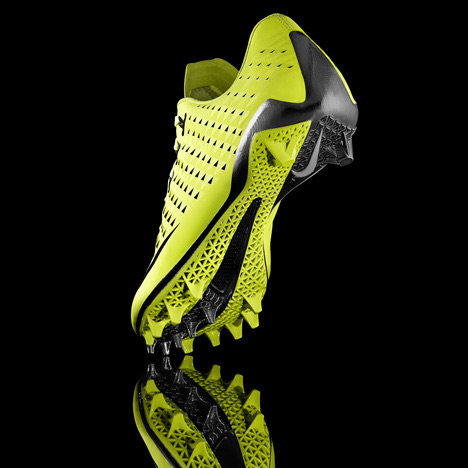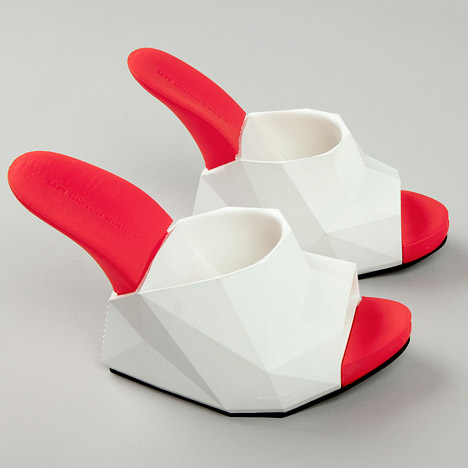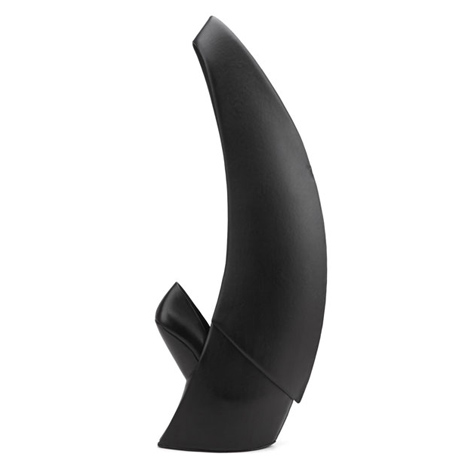
"The fashion industry has finally woken up"
Fashion and technology: sports brands like Nike and Adidas have been leading "technological innovation" in shoe design but the fashion industry is finally beginning to wake up to the possibilities of digital technologies, says Rem D Koolhaas, co-founder of footwear brand United Nude (+ interview).
"Fashion is actually running behind with the use of technology if you compare it with architecture and product design," Koolhaas told Dezeen.
"That's perhaps also the reason why outsiders from the world of fashion have helped and are still helping to stir things up and push boundaries. The fashion industry itself often prefers to run in circles."
However, Koolhaas thinks that brands like Adidas and Nike are setting the bar for the fashion industry by using technologies for practical applications – creating new materials and techniques through specialist sportswear designs like digitally knitted football boots.
"A lot of technological innovation that's actually useful is done for performance purposes by the sports brands," he said.

"The problem with many of the most advanced technologies is that only the big companies can get their hands on them through big budgets and mass production. Compared to some of the sports brands, everybody else is old fashioned when it comes to technology."
Koolhaas launched his footwear brand 11 years ago with the Möbius shoe, which he first designed in 1999 while studying architecture in the Netherlands.
United Nude's latest release is a shoe that can be 3D-printed at home on a compact desktop machine, and the company has frequently collaborated with 3D-printed Haute Couture pioneer Iris van Herpen to print the footwear for her catwalk shows.
Koolhaas admitted he is "just a small experimentalist" compared to the sportswear giants, but that the leaps made by Nike and Adidas are now paving the way for others to follow suit.

"The good thing is that the door is now open and that the fashion industry has finally woken up," Koolhaas said, stating that young fashion designers who are being taught to use, and experiment with, digital technology will be the ones to step up to the challenge.
"Some of the best fashion schools are now really promoting technology, which I think is a very positive development. Not everything that will be tried will work, but there's only one way to find out."
Read on for an edited version of the interview with Rem D Koolhaas:
Dan Howarth: What has the fashion industry gained from digital technology?
Rem D Koolhaas: Fashion is actually running behind with the use of technology if you compare it with architecture and product design. It's stuck in its way and with the seasonal calendars and therefore it's limited in time for development. That's perhaps also the reason why outsiders from the world of fashion have helped and are still helping to stir things up and push boundaries. The fashion industry itself often prefers to run in circles.
Dan Howarth: What new materials and processes have already been successfully integrated into fashion?
Rem D Koolhaas: 2D printing of fabrics, 3D printing, injection moulding and 3D weaving like for socks and shoes. A lot of technological innovation that's actually useful is done for performance purposes by the sports brands. When a dress or a shoe is 3D printed it's still more experimental than functional.

Dan Howarth: What are the most important digital technologies currently used in fashion?
Rem D Koolhaas: 3D printing might soon be as there's a huge potential. For the moment 3D weaving is pretty big too, but this also depends on how you define fashion.
Dan Howarth: How can 3D printing be developed to improve its suitability for fashion?
Rem D Koolhaas: I sometimes think that the ultimate method of 3D printing is not yet invented, or not yet available. This method will be cheaper, faster and more flexible in choice of materials. So perhaps not current technologies as you say, but a new form. For now laser sintering comes closest as it's the most advanced, but it's slow and costly.
Dan Howarth: How will digital technology benefit the fashion industry in the near future?
Rem D Koolhaas: Somebody from Nike should answer this question, I'm just a small experimentalist compared to them. The good thing is that the door is now open and that the fashion industry has finally woken up.
Dan Howarth: What about biological materials and processes? How are they influencing the way we design clothes?
Rem D Koolhaas: 3D growing used with 3D printing is a beautiful sustainable way forward, with silk-spinning insects living in new 3D bio printers... I will discuss this in my next meeting with [technology company] 3D Systems. For now recycling in fashion is already a huge challenge and for designers to design good fashion with a certain timelessness.

Dan Howarth: How will clothes and accessories become better integrated with the body?
Rem D Koolhaas: Through design evolution. The problem with many of the most advanced technologies is that only the big companies can get their hands on them through big budgets and mass production. Compared to some of the sports brands, everybody else is old fashioned when it comes to technology. When they collaborate more with really clever designers instead of the more popular ones they could make bigger steps.
Dan Howarth: What developments are you currently working on that bridge technology and fashion?
Rem D Koolhaas: We are doing more 3D-printing projects than ever before, but not necessarily as a functional exercise, but more as a play on form and shape. A lot of our experimenting with technology we do for fun and to push boundaries rather than to re-invent the wheel.
Dan Howarth: Has the fashion industry accepted technology yet?
Rem D Koolhaas: Not the old guard. You can see that in their horrible interpretations of the fashion forecasts. You can see that most clearly, for instance, with some sneaker design by the big luxury fashion brands. But you see a lot more experimentation by young brands and young designers these days. Some of the best fashion schools are now really promoting technology, which I think is a very positive development. Not everything that will be tried will work, but there's only one way to find out.